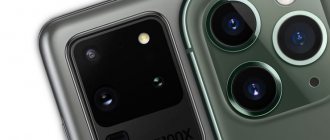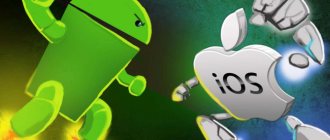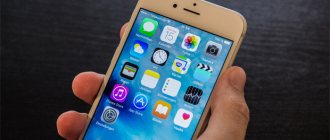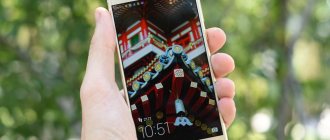Android vs iOS is one of the eternal battles. Fans of each system regularly clash over who is better. We decided not to stand aside and look at seven important parameters to find out which mobile operating system performs better.
Photo: tomsguide.com
Design
General design trends always affect the appearance of operating systems. From three-dimensional icons, fashion has moved to flat ones, and now visually almost all axes are similar to one another.
Changed Android system design. Photo: lifewire.com
iOS
Apple's operating system has not received visual updates for a long time. The home screen is still divided into the dock (a panel at the bottom of the screen with quick access to main applications) and application icons, which can be put into folders.
After the release of iOS 14, a page with widgets appeared in the system. It opens by swiping to the right. It displays in blocks a gallery of photos with a random selection, a calendar, weather, a map and much more. The widget panel can be customized to suit your needs. The system looks very neat. All applications are easily accessible.
This has both a plus and a minus - iOS does not change, even if the user would like to customize it for himself. The most you can do is set your own wallpaper and change the location of applications, including the application in the dock.
Among the convenient functions on iOS, there is a drop-down menu with access to applications, for example, an alarm clock, a flashlight, quick access to screen brightness and volume. The list of drop-down functions can be customized. The menu opens by swiping up. Swiping left opens the app gallery and search.
Android
Pure Android is the basis on which each manufacturer puts its shell. But the principle remains similar: on the main page there are several quick access icons, a dock and Google search. Swipe to the right to open other apps, and swipe to the left to open widgets. On Android they are placed in a list of blocks - just like Apple notifications look like.
Swiping down opens a drop-down menu with settings. Android has more of them than Apple: there is screen casting, hotspot, GPS, screenshot, etc. The remaining settings in the menu, depending on the interface or shell, can be placed chaotically or confuse the user. So, on MIUI from Xiaomi, the screen orientation and lock icons are very similar.
But the design customization capabilities definitely put Android ahead of iOS in this regard. Here you can change the application icons themselves, their design, shape and animation.
In general, both visually and in terms of management, the home screen of both operating systems is similar. As for the convenience of each of them, it is rather a matter of habit.
iOS - 0
Android - 1
Cameras
By cameras. I'll get ahead of you, you will certainly write that the camera on the iPhone is bad. This is true. The results obtained with the camera of such an expensive smartphone are simply shameful. Instead of people, there are red pancakes, so to speak.
It’s generally impossible to shoot at night. Well, for everyday tasks it is quite capable. That is, the sea is beautiful to photograph; a UFO, if it flies on a bright day right next to you at a distance of 15 cm, then the photographs will turn out. And one more thing, what do all your favorite Instagram bloggers use to take pictures?
Naturally, on the iPhone, no matter who advertises. But the camera is really, in terms of photography, very bad. But according to the video, this is still the standard. Both in sound and in picture.
By the way, I went to the Metallica concert in Moscow, compare. Record video from Galaxy S10. And now with iPhone 10S Max. So how? Where is the sound better, where is it worse? Again, write, but, in my opinion, everything is obvious here. Let's return to the photo. This is why I continue to carry two smartphones with me.
On the iPhone I shoot video, and on the Samsung or Pixel or Huawei P30 Pro I take photography. They all do noticeably better than the iPhone.
Although, I’m really looking forward to the Pixel 4. And if they put a wide-angle lens on it, I’ll most likely switch to the Google Pixel 4. Well, or at least make it my second phone. But I’m even more looking forward to the iPhone 11, where a wide-angle lens should also appear. And Apple, please work on the software. At least to compete a little with Google, because now it’s about, well, that’s it. Heaven and earth.
Usability
How easy is it to navigate the system, find the settings you need, and what can you customize? This is where the difference between operating systems becomes noticeable; the principle of their operation is fundamentally different.
Pages on the iOS 14 home screen. Photo: wrcbtv.com
iOS
Apple's mobile operating system is very easy to use. It is intuitive and the path to most settings is easy to follow. The most important thing is to remember a few basic management principles. Swipe to the right - application library, to the left - widgets, down - notifications, up - list of open applications.
But this simplicity is easily explained: there are not many parameters that can be configured. Basically, the most important things: wallpaper, login passwords, data transfer to the cloud.
Apple expects users to figure it out on their own—no instructions are included with the devices. For an advanced user it is really simple, but a beginner may face problems in controlling the smartphone. If you are used to Android, then there will also be unusual moments, because the basics of control are very different.
Android
The main difference between Android is the openness of the system. And the point is not only that it can be almost completely redesigned, but that the settings concern even the smallest elements: types of notifications, desktop organization, updating individual system components.
In addition, Android also has advanced settings that include detailed privacy settings.
iOS - 1
Android - 0
Applications
List of applications on the Android system. Photo: nextpit.com
iOS
Apple is careful about its products and system security. You can only install applications that are available in the official AppStore. For any other manipulations, you need to reflash the phone, and this will automatically void the warranty. Because of this, the choice of applications is limited.
Additionally, not all apps are available in all countries, and if you want to try a game that hasn't yet been released in your home region, the only way is to switch the app store to a foreign one. In this case, all installed applications, even if they are present in the store of the selected country, stop updating.
Android
Android allows you to install applications from several stores at once: Google Play, the official Android store, the user interface store added by the manufacturer, and any apk file - the application installation file.
To access an application from a store in another country, simply search for the apk of an interesting application in a search engine and install it. You can update it in the same way.
But the creators of the system, of course, cannot guarantee the ideal operation of such applications.
However, Android allows you to install different applications, including those that change system settings: design, additional widgets, etc. And the choice of applications is much larger.
iOS - 0
Android - 1
Iron
I forgot to say about the hardware. No matter how hard Qualcomm tries, Apple manages to make more powerful and cooler chips every year. The iPhone has so much power that it doesn't know what to do with it because everything is flying.
No games have yet been written for this chip that would use it to its full capacity.
Therefore, in theory, it should be enough for many, many years to come, although interface glitches still occur.
But if we talk about Samsung Exynos, then this is generally sad, compared to Qualcomm, compared to A12.
And, unfortunately, in Russia we don’t sell the Samsung version on Snapdragon, but I’m still in favor of buying it. Although there are also some disadvantages there.
Data Security
Security settings in the iOS system. Photo: imore.com
iOS
In Apple's operating system, the rules are simple: files are stored either on the device or in the cloud. iCloud accounts are rarely hacked, and after such cases the system is always checked and updated. User information is securely protected. By the way, general security updates are released regularly.
The device is locked with a password. In older models, this is a Touch ID fingerprint scanner, and in new ones, very advanced FaceID facial recognition. The same protection is provided by individual developers in some applications - mainly banking ones. But most of the data, including payment, will be available to those who know the digital password - it is on all smartphone models.
The keychain function, which remembers passwords, works through FaceID. But if you are already logged into your account, then there is no additional protection.
Android
Android allows you to password protect even individual documents or applications.
If you want to hide some data, you can even use a second space - a clean copy of the system on which other applications and files are installed. Access to it can also be closed with a password.
Another difference and at the same time problem with Android is its susceptibility to viruses and hacks. This is a consequence of the openness of the system - you can download and upload almost anything into it. Therefore, it is important to install antivirus applications.
Most Android smartphones still protect data with a fingerprint scanner, since the face scanner is not considered secure enough - in rare cases, it reads a photo and mistakes it for a face.
iOS - 1
Android - 0
Invest in protection
Along with regular updates, consider investing in other technologies that will help protect your personal and sensitive data. Using a VPN connection is also a great way to secure your mobile devices. If you have a secure VPN, you can transfer banking information, credit card information, and other personal information through unsecured Internet servers without exposing yourself to much risk.
Companies that allow employees to use their own devices or assign them company-owned smartphones may need stronger security. There are quite a large number of options on the market. Either way, ensure your safety before a problem occurs.
Additional links on the topic:
- What is VPN
- Protecting Android from mobile threats
- Mobile security and tips for protecting your smartphone
- Mobile threats: protecting smartphones and tablets
Ecosystem
Google Docs icon on iOS. Photo: itechguides.com
iOS
Since iOS is designed for users of Apple technology, it ideally interacts with the company’s devices through a single Apple ID account. Text copied on the computer can be pasted on the phone, you can use the smartphone as a trackpad (Apple touchpad), information in applications and tabs, as well as passwords are available from any device. Files are available through the iCloud cloud, music through Apple Music streaming, and videos through AppleTV.
Everything is tied to your Apple ID account. By the way, it can be used even on Windows, but applications will be reluctant to work - they slow down and often freeze. However, the Apple ecosystem is very rich in convenient features.
Android
Android can rely on both a Google account and the account of the manufacturer. You can store data in the cloud and copy passwords from Google Chrome. But Android does not have the same unity with computers as Apple does. For example, it is impossible to simply open a photo in both places. To do this, you need to upload it to the cloud, go to the cloud through a browser or folder and look for the image there. It takes longer and is not suitable for everyone.
iOS - 1
Android - 0
Pros of Android
A separate article was devoted to the advantages of the Google operating system, where we identified 9 reasons to choose Android:
- Wider selection of smartphones.
- Availability of truly affordable devices.
- MicroSD card support.
- Possibility of using two SIM cards.
- The presence of a 3.5 mm audio jack on smartphones.
- Ease of downloading and using media files.
- Interface customization.
- Openness of the system.
- Availability of accessories.
Agree, today some of these advantages can be called completely insignificant. For example, support for microSD cards and the convenience of downloading media files in the era of cloud services are no longer so important. And not everyone needs an audio port in smartphones, especially when TWS headphones can be bought for about 1 thousand rubles.
The bottom line is that the indisputable advantages of Android, I would say, are a large selection of devices at various prices and wide possibilities for customizing the interface: you can choose from many custom shells, launchers and utilities that allow you to tailor the interface to your needs. This is truly something to give Android preference for.
Update
The process of updating the system on an Android smartphone. Photo: techadvisor.com
iOS
Apple updates the operating system on all devices released over the past few years. This happens automatically and there is no need to pay extra for the update. The only negative is accusations against the company of deliberately slowing down systems on outdated devices. There is no confirmation of this, but the older the device, the slower the axis reacts on it.
Android
Android updates vary by device manufacturer. The company releases updates for some phones almost immediately, while others, on the contrary, remain unupdated. In addition, you need to ensure that the interface version is updated. And smartphones from Huawei, due to the company’s conflict with the United States, were completely left without Google applications.
Apple - 1
Android - 0
Family Sharing
Family Sharing allows users who have set up Family Sharing to share purchased content with up to 6 additional people. The feature also allows parents to control their children's purchases. For example, if a child goes to the App Store and clicks on purchase, a notification about this will pop up on the phone of one of the parents. Mom or Dad will be able to either approve or reject the purchase. In addition to monitoring spending, parents can use this function to see where their children are.
Additional system functions
Photo review of iOS 15 features. Photo: apple.com
iOS
- In iOS it is more difficult to download files - third-party music, ringtones, even books are always more difficult to download, since it is impossible to download them directly from the Internet. You can use instant messengers, but the files will only be stored for a limited time.
- The iOS camera app offers several filters, but no advanced settings (exposure, light sensitivity).
Android
- Many different functions, the list of which depends on the manufacturer.
- Some smartphone manufacturers and models, for example, Google Pixel camera phones, have advanced photo and video settings. They are almost like on professional cameras.
- You can download not only files, but also applications.
iOS - 0
Android - 1
Setting a ringtone
This operation is familiar to everyone who has ever held a mobile phone in their hands. In order to set your favorite melody for a call, you need to download it from the Internet, call the file properties and define it as a ringtone for a call. It is also possible to set the downloaded melody as a ringtone for a specific group of subscribers. Of course, owners of iOS devices also have the opportunity to set their own ringtone. But the whole point here is to realize this opportunity.
On Android we can set any ringtones for the call . In devices above iOS, we will need iTunes - here we select the desired melody, trim it, convert it to another format, and synchronize it. Do you feel how much more body movements are needed for such a simple operation?
In terms of the ease of setting your own ringtone for a call, Android devices unconditionally win - ringtones are set in the same way even in the simplest push-button handsets.
Bottom line
Smartphones Apple iPhone on iOS and Google Pixel on Android. Photo: cnet.com
In our ranking, iOS wins by a small margin. It wins in terms of usability, data security, ecosystem functionality and updates. Android performed better in axis design, variety of applications and additional features.
The two operating systems are not that different. Therefore, we recommend making a choice based on the parameters that are most important to you.
Voice assistants
TV screens teach us how to communicate with Google’s voice assistant, which is activated by the phrase “Okay, Google.” The assistant is really interesting, but has little functionality. It can set alarms, show the weather forecast, work with reminders and maps. But you can talk to Siri in almost human language. And this assistant has more impressive functionality. Therefore, this time iOS devices became the leaders in the battle between iOS and Android - Siri surpassed Google Now .
And even the new Alice assistant from Yandex cannot yet bypass Siri.











